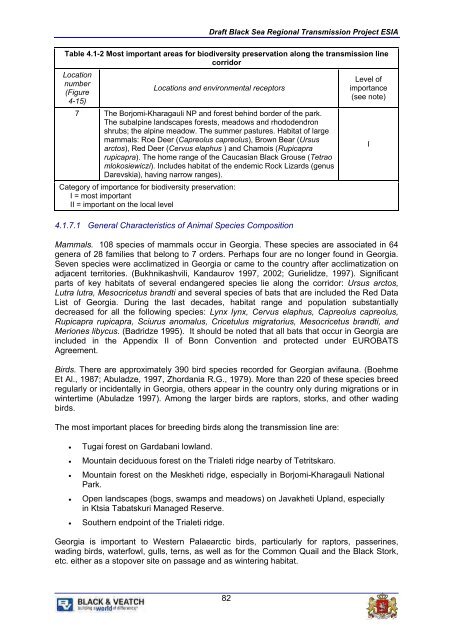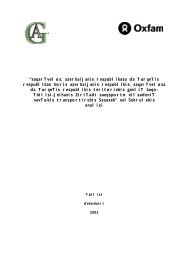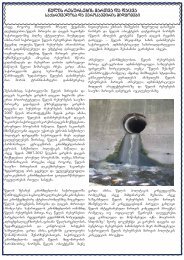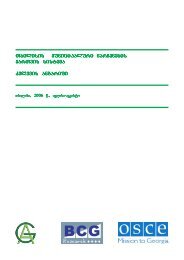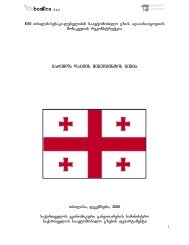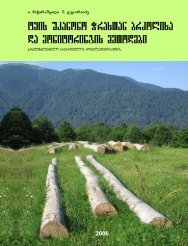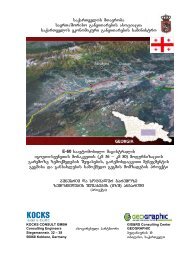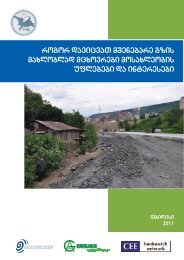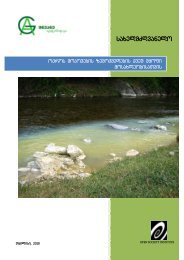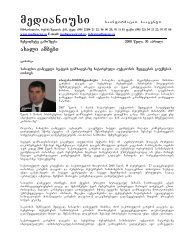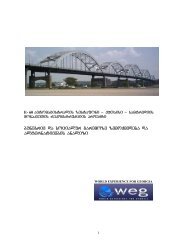Part I
Part I
Part I
You also want an ePaper? Increase the reach of your titles
YUMPU automatically turns print PDFs into web optimized ePapers that Google loves.
Draft Black Sea Regional Transmission Project ESIA<br />
Table 4.1-2 Most important areas for biodiversity preservation along the transmission line<br />
corridor<br />
Location<br />
number<br />
Locations and environmental receptors<br />
(Figure<br />
4-15)<br />
7 The Borjomi-Kharagauli NP and forest behind border of the park.<br />
The subalpine landscapes forests, meadows and rhododendron<br />
shrubs; the alpine meadow. The summer pastures. Habitat of large<br />
mammals: Roe Deer (Capreolus capreolus), Brown Bear (Ursus<br />
arctos), Red Deer (Cervus elaphus ) and Chamois (Rupicapra<br />
rupicapra). The home range of the Caucasian Black Grouse (Tetrao<br />
mlokosiewiczi). Includes habitat of the endemic Rock Lizards (genus<br />
Darevskia), having narrow ranges).<br />
Category of importance for biodiversity preservation:<br />
I = most important<br />
II = important on the local level<br />
4.1.7.1 General Characteristics of Animal Species Composition<br />
Level of<br />
importance<br />
(see note)<br />
Mammals. 108 species of mammals occur in Georgia. These species are associated in 64<br />
genera of 28 families that belong to 7 orders. Perhaps four are no longer found in Georgia.<br />
Seven species were acclimatized in Georgia or came to the country after acclimatization on<br />
adjacent territories. (Bukhnikashvili, Kandaurov 1997, 2002; Gurielidze, 1997). Significant<br />
parts of key habitats of several endangered species lie along the corridor: Ursus arctos,<br />
Lutra lutra, Mesocricetus brandti and several species of bats that are included the Red Data<br />
List of Georgia. During the last decades, habitat range and population substantially<br />
decreased for all the following species: Lynx lynx, Cervus elaphus, Capreolus capreolus,<br />
Rupicapra rupicapra, Sciurus anomalus, Cricetulus migratorius, Mesocricetus brandti, and<br />
Meriones libycus. (Badridze 1995). It should be noted that all bats that occur in Georgia are<br />
included in the Appendix II of Bonn Convention and protected under EUROBATS<br />
Agreement.<br />
Birds. There are approximately 390 bird species recorded for Georgian avifauna. (Boehme<br />
Et Al., 1987; Abuladze, 1997, Zhordania R.G., 1979). More than 220 of these species breed<br />
regularly or incidentally in Georgia, others appear in the country only during migrations or in<br />
wintertime (Abuladze 1997). Among the larger birds are raptors, storks, and other wading<br />
birds.<br />
The most important places for breeding birds along the transmission line are:<br />
I<br />
<br />
<br />
<br />
<br />
<br />
Tugai forest on Gardabani lowland.<br />
Mountain deciduous forest on the Trialeti ridge nearby of Tetritskaro.<br />
Mountain forest on the Meskheti ridge, especially in Borjomi-Kharagauli National<br />
Park.<br />
Open landscapes (bogs, swamps and meadows) on Javakheti Upland, especially<br />
in Ktsia Tabatskuri Managed Reserve.<br />
Southern endpoint of the Trialeti ridge.<br />
Georgia is important to Western Palaearctic birds, particularly for raptors, passerines,<br />
wading birds, waterfowl, gulls, terns, as well as for the Common Quail and the Black Stork,<br />
etc. either as a stopover site on passage and as wintering habitat.<br />
82


